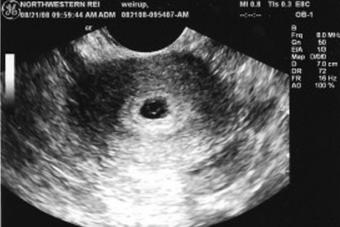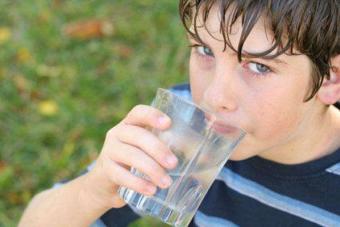When a foreign object enters the animal’s stomach, its functioning is disrupted, which is characterized by the absence of peristalsis, the mucous membrane becomes inflamed, the stomach becomes denser, and edema develops. In the place where the foreign body has entered the cat and dog, ulcers develop and the tissues begin to become necrotic. At the site of the necrotic tissue area, the tissue becomes thinner, perforation of the stomach walls occurs and, as a result, peritonitis.
If a cat or dog swallows a foreign body and it remains in the stomach, then irritating the mucous membrane, after a while a characteristic symptom appears - vomiting after eating. A foreign body with sharp corners causes severe pain, as well as disruption of the integrity of the stomach walls. The presence of such an object in the stomach injures the walls, and the animal’s feces are blackish with streaks of blood and mucus. In some cases, foreign bodies lie in the stomach for a long time, without causing virtually any characteristic symptoms or obstruction. But during this period, the animal may periodically vomit, gradual dehydration occurs, the coat becomes dull, anemia develops, and the oral mucosa turns pale. The animal becomes lethargic, apathetic, and a characteristic gait appears less mobile. Visually, there is a feeling of a “humpbacked back”; this is due to constant pain in the stomach area (P.Ya. Grigoriev, E.P. Yakovenko 1997; N.V. Danilevskaya, 2001).
With partial intestinal obstruction, animals develop loose stools, periodically vomiting undigested (or semi-digested) food, seething in the abdomen, and pain. Complete obstruction is characterized by the absence of defecation; after consuming food, vomiting occurs after a while. The abdomen is tense, painful, and strong seething is felt (I.V. Kozlovsky, 1989; F.I. Komarov, 1992; V.A. Gubkin 1995).
The main diagnosis of the presence of a foreign body in the stomach in dogs is radiography and, as an auxiliary diagnosis, ultrasound examination.
If there is a suspicion of a foreign body in the stomach, an X-ray examination is carried out using a contrast agent; barium sulfate is mainly used in veterinary medicine.
Technique of radiographic examination. Before the study, it is necessary to keep the animal on a 12-24 hour fasting diet. The diet reduces gas formation and during radiography, gas bubbles will not distort the images, casting shadows and causing darkening in the images. Barium sulfate is diluted with milk or curdled milk in an amount of 25-150 grams of the substance, depending on the weight of the dog or cat and the topography of the study. This mixture is fed either freely if the animal eats food, or forcibly using a probe or syringe 30-60 minutes before the study (L.P. Mareskos, 1999; G.V. Ratobylsky, 1995; G.A. Zegdenidze, 2000 ).
The photographs are taken in a standing position or in a lying position on the right side. Several pictures are taken from different positions; if necessary, pictures are taken after 30 minutes, 1 hour, 4 hours and 24 hours. This frequency gives the exact location of the site of blockage in the gastrointestinal tract.
The method of radiographic examination with a contrast agent makes it possible to clearly determine the presence of a foreign body in the stomach, regardless of its size (Appendix 1) (K. Khan, Ch. Hurd 2006; G.A. Zegdenidze, 2000).
Ultrasound diagnostic testing is also carried out.
Technique for conducting ultrasound examination. Before the study, the animal is prepared; it consists of a 12-18 hour fasting diet with the administration of activated carbon or drugs that reduce gas formation. The animal is laid on its right side, the hair at the site where the sensor passes is cut off, this is necessary so that the image is clearer (Appendix 2) (F. Barr, 1999; B.S. Kamyshnikov, 2000; A.Ya. Althauzen, 1995).
Dogs love to chew on bones, but the sharp edges and pieces can be harmful to their digestive system. If your pet shows lethargy, coughs, refuses to eat, trembles its stomach and body, and blood is visible during bowel movements, these may be signs of damage to the intestinal walls and other organs of the digestive tract from bone fragments.
When a dog has eaten a bone and later shows signs of ill health, it should be given first aid at home and then taken to the veterinarian.
Chicken bones from young broilers are not dangerous for dogs. They can be given boiled or raw. They are easily chewed and are malleable to healthy dog teeth. If your dog eats a chicken bone from a supermarket bird, there is no need to worry.
Chicken bones from village laying hens that have been raised for more than a year are much worse for your pet’s health. Poultry bones are hard and strong; when broken, they have dangerous sharp edges that can cut the dog’s intestines or stomach, pierce the walls of organs, cause internal bleeding and death of the animal. At the first symptoms of damage to internal organs, the dog should be taken to the veterinary clinic for an x-ray.
The dog ate a fish bone
Fish bones are very thin and sharp. They are not visible on x-rays and can only be detected by an experienced specialist. On the one hand, fish bones are not very dangerous for the pet’s life. They do not block the airways and do not lead to suffocation. However, when pierced, the needle-like bones cause unbearable pain, the dog begins to whine, suffer from insomnia, and refuse water and food.
If your dog has eaten a fish bone and it is stuck in the larynx, you can remove it with tweezers. To do this, one person fixes the mouth in an open position, the other, armed with tweezers sterilized with alcohol, must pick up, securely clamp the tip of the bone and pull it out of the larynx in one confident movement.
A dog that has swallowed a bone should not be offered solid food, as it may dig the bone further into the tissue or break it. This will make it difficult to remove the pointed object. If you cannot help your dog at home, you should always contact a veterinarian. When examining the larynx, specialists use an oral speculum.
Veterinarians strongly advise against giving adult dogs and puppies tubular bones. They can simply be swallowed whole or chewed into small pieces with sharp edges. In both cases, harm is caused to the health of the pet.
What dangers can await if a dog has eaten a tubular bone:
- Infection from chicken, rabbit, beef or pork bones, if the killed animal suffered from infectious diseases. Even high cooking temperatures do not destroy some types of bacteria in the bones.
- Damage to the fragile enamel of the baby teeth of puppies, and grinding down of the molars of adult dogs. The sharp edges of the tubular bone often damage the gums.
- Bones and their fragments are not digested by the gastrointestinal tract of dogs, but are compressed into dense masses. This causes constipation and gas formation.
- A dog can choke on sharp fragments. Bone particles can injure the esophagus, stomach, intestines, cut the walls of organs, and cause peritonitis.
Dog owners should monitor their dog's behavior and condition after noticing that their pet has swallowed a bone. If the dog begins to cough, even vomiting, wheezing, choking, experiencing weakness, pain, or difficulty swallowing, it is necessary to provide immediate assistance.
What to do if your dog swallows a bone and gets sick:
- It is necessary to inspect the mouth with a flashlight. If the bone is embedded in the back wall of the larynx and is visible, try to pull it out with your hands or tweezers.
- If the pet is coughing, small dogs are grabbed by the hind legs and lifted. Large dogs are tilted upside down. Foreign objects come out with a strong air stream when exhaling sharply.
- When a dog cannot clear its throat, has choked on a bone and is suffocating, the Heimlich maneuver is used. The dog is pressed with its back to itself, the hand, gathered into a fist, is placed in front of the sternum. In the area of the diaphragm, apply 4-5 sharp pressures with your fist. If after this the bone does not come out, urgent hospitalization of the animal is required.
- For abdominal pain and blood in the stool, the dog is given 10 ml of vegetable oil from a syringe without a needle, which facilitates the passage of bone fragments from the intestines.
- It is recommended not to give food or water to the dog for 3 days. Fasting helps restore damaged walls of the gastrointestinal tract.
- When the dog begins to feel better and blood stops coming out in the stool, a strict diet should be followed for several days. The dog is fed bread soaked in milk and oatmeal. Solid food is temporarily not given.
Opinions about this are mixed. Pets react positively to some types of bones.
Young healthy dogs do not suffer much from swallowed bones and quickly recover from damage. But still, if you have serious symptoms of illness, you should definitely contact a veterinarian in order to alleviate your pet’s condition and avoid complications.
A foreign body in the esophagus in dogs is quite common in clinical practice. The most common foreign bodies found in dogs are bones, bone fragments and coins, while toys are more often found in puppies.
Many canine esophageal foreign bodies are expelled by regurgitation or move to the distal gastrointestinal tract, but some remain in the esophagus. A large foreign body that cannot pass through the esophagus causes mechanical obstruction. The severity of esophageal injury depends on the size of the foreign body, whether it has corners or sharp projections, and the duration of the obstruction.
Diagnostics
Clinical signs. In many cases, owners report that their pet has ingested a foreign body. In some cases, this happens unnoticed, especially if the animal is prone to eating garbage. The onset of clinical symptoms will depend on the degree of esophageal obstruction. Animals with complete obstruction often show acute symptoms, whereas animals with partial obstruction may take days or weeks to show signs. Clinical symptoms are: regurgitation, hypersalivation, odynophagia, anorexia, dysphagia, retching and tachypnea.
Diagnostic Imaging. Bone foreign bodies can sometimes be identified by palpation if they are located in the cervical esophagus, but radiographic examination is usually necessary to make a definitive diagnosis. Radiopaque foreign bodies can be detected by plain radiography, but administration of contrast agents is required to confirm the presence of radiolucent objects. Contrast agents should be used with caution if esophageal perforation is suspected. A foreign body in a dog can be identified (and removed) during an endoscopic examination. A preliminary diagnosis of the presence of a foreign body can be made if the owner reports his animal ingesting a foreign body and the animal exhibits signs of esophageal dysfunction.
In the absence of information about the ingestion of a foreign body by a dog, the main differential diagnoses are: esophageal stricture, neoplasia, hiatus, and gastroesophageal stricture. Any of these conditions can be excluded using radiographic and/or endoscopic studies.
Treatment of dogs with a foreign body in the esophagus
A foreign body from the esophagus in dogs must be removed as quickly as possible. Its prolonged presence in the lumen of the esophagus increases the likelihood of damage to the mucous membrane, the appearance of ulcerations and perforation. The initial stage of treatment in this case is to search for a foreign object using a rigid or flexible fiberoptic endoscope, although a fluoroscope can also be used for this purpose. A rigid endoscope is the most suitable instrument for detecting large foreign bodies, especially bones or bone fragments. Large grasping forceps are inserted through the rigid endoscope to remove the foreign body, and in many cases it can be pulled into the endoscope and removed safely. Large foreign bodies that cannot be safely removed through the mouth can in some cases be advanced into the stomach and then removed through a gastrotomy. Small foreign bodies in dogs are best removed using a flexible fiberoptic endoscope and a basket, retainer, or surgical snare. Flexible endoscopes are especially useful for removing fish hooks.
Sick animals should not be given food for 24-48 hours after removal of the foreign body. Longer periods of food restriction may be necessary if the esophageal wall is necrotic or ulcerated. In this case, animals can be fed through a gastrostomy tube inserted during the endoscopic examination. Specific therapy for esophagitis should include oral administration of sucralfate suspensions. Sucralfate suspension is more effective than tablets. Consideration should be given to the use of glucocorticoids (eg, prednisolone) at an anti-inflammatory dose in animals with suspected esophageal stricture. The risk of narrowing of the esophagus is greatest when the mucous membrane is ulcerated within 180°, that is, half the circumference of the lumen of the esophagus. Finally, broad-spectrum administration to animals with severe ulceration or small perforations may be considered appropriate.
Surgery indicated if the foreign body could not be removed during endoscopic examination or if there are signs of esophageal perforation. Gastrotomy is preferable to esophagotomy when the foreign body is in the distal part of the esophagus, since the surgical wound on the esophagus heals less well; in addition, there is a possibility of stricture formation. However, esophagotomy is certainly indicated in cases where the foreign body cannot be removed by gastrotomy. If perforation of the esophagus occurs, surgical intervention is also necessary.
Bones are a treat for dogs, but not all of them are as safe for the animal as they seem. Many owners believe that such a “treat” is the best food for their pets, but this is a completely wrong opinion. The consequences that occur after such a diet are quite dire, so much so that they lead to death.
It is prohibited to give chicken bones in any form, neither boiled, nor smoked, nor raw, due to their excessive fragility for the animal’s teeth.
You should not give your dog chicken bones.
When a pet bites them, the bones break into many particles that affect: the palate, gums, esophagus, and internal organs of the digestive tract. Crushing chicken bones inside – obstruction, intussusception.
Even more significant damage is caused by the fish skeleton and its smaller branches. Dog teeth are quite large and not designed for processing such “food”. The presence of small fish particles inside the intestines - blockage, punctures, injuries to the wall of the organ mucosa.
Harm
- As for harm to dogs, small fish fragments pierce the mucous membranes of the stomach and intestines, damage the entire digestive tract .
- Among other things, more small fragments can create blockages in the lumens of the abdominal organs . Such a blockage can only be removed through surgery or even cost the animal its life.
Fish bones can damage the stomach lining.
Conditionally safe dice
Beef or pork bones are considered relatively safe.
True, not all parts of the skeleton. You can let the dog chew on large muscles. Your pet will not be able to bite such a block into small fragments, but it will sharpen its teeth and enjoy it. The nutritional value of such food is very questionable, but dogs are creatures from the family of carnivores and they need to constantly prove their worth in this regard. But it should be remembered that exceptions also happen and are rare, but such bridges can also split, so you should be careful.
Larger bones are safer for your dog.
Sugar Bones
But you can also occasionally give your pet so-called “sugar bones”, on which a little vein or meat remains.
You can give your dog bones that have meat on them.
Such parts of the skeleton practically cannot be crushed, which makes them as safe as possible and can be used as a treat for a dog. The nutritional value, however, is also questionable, but it can be used for the pleasure of your pet. In addition, “gnawing” the bones acts as a kind of prevention of tartar and plaque.
How to tell if your dog has a bone stuck in his throat
If the owner has not personally witnessed the consumption of dangerous food, there are a number of signs that may indicate problems. Main symptoms:
Nausea is the main syndrome of bone stuck in the throat.
Some of the listed symptoms are general, and some indicate the direct presence of a foreign object in a certain place.
Symptoms
- The presence of fragments in the esophagus will “manifest itself” immediately after eating.
- The dog begins to lick his lips and opens his mouth wide.
- Consuming even small amounts of food or liquid leads to nausea and vomiting.
- When trying to eat or drink something, the dog chokes and coughs.
- Vomit contains remnants of undigested food and is twisted into ropes.
- Against this background, dehydration and weight loss begin.
- If bone fragments are in the stomach, vomiting begins two hours after eating. This usually happens when the pet’s diet is constantly supplemented with bones, which subsequently leads to the formation of conglomerates that clog the lumen.
- The most severe condition is when foreign fragments are localized in the intestines.
- The dog's stomach becomes very bloated and flatulence begins.
- Severe pain is recorded.
When trying to eat, the dog coughs.
What to do (first aid)?
You can help your pet yourself only if a foreign body is stuck between the teeth and you can see it. To do this, you can use tweezers and a flashlight. However, if the fragments have passed further and have already injured the mucous membranes, only surgical intervention can help the dog.
- Under no circumstances should you induce vomiting in your dog. . During vomiting, the contents are expelled, but at the same time they can damage all the mucous membranes that get in the way. Then the pet is guaranteed to die. A possible help for minor blockages would be to feed the dog a large amount of bread or boiled cold rice.
- A large volume of fibrous food can envelop the mucous membranes, subsequently gently removing sharp debris from the body. You can mix bread and rice, add your favorite food and feed it to your dog. Over the next few days, all symptoms will disappear. If this measure does not help and the dog continues to behave suspiciously, the patient should be urgently taken to the clinic.
- The presence of fragments and damage in the stomach requires removal of the damaged part of the stomach followed by restorative therapy. Often bone fragments provoke intestinal obstruction and intussusception. In such cases, only surgery will help. In some cases, you can get by with the endoscopic method of removing a foreign body from the stomach cavity. But with intestinal intussusception, this method will not bring the desired effect; partial resection may be a possible method of relief.
- If there is the slightest suspicion of an alleged pathology, under no circumstances should you hesitate . Restorative treatment involves prescribing antibiotics to avoid possible complications and the development of infection. Symptomatic therapy is used - painkillers, antispasmodics, drugs that reduce body hyperthermia.
If the jam is shallow, you can use tweezers.
Prevention
Prevention consists of paying close attention to your pets. Develop a diet according to your doctor’s recommendations. Do not allow consumption of “random” food, limit walking in dangerous places that are located near garbage containers or landfills. The key to a pet’s health is care and attention, a timely response to the animal’s suspicious behavior.
Worried about possible intestinal obstruction in dogs? If your dog eats everything in sight, you may well be faced with this problem. Every year, the list of items dogs ingest becomes more and more impressive. Among them there are coins, bones, sticks, toys, socks, stones, buttons, underwear, balls and tampons.
Symptoms
The most common symptoms are vomiting, loss of appetite, abdominal pain, and difficulty defecating. Considering that any object can pass through the animal’s digestive system within 10-24 hours, the main symptoms usually appear after 24 hours. True, depending on the location of the obstruction, the timing of its manifestation may vary. With esophageal obstruction, symptoms appear fairly quickly. The dog will often lick its lips and burp after eating. When regurgitating, you can see large pieces of undigested food. A sick dog may become severely dehydrated because it is unable to eat and drink properly. Due to the inability to eat, dogs quickly begin to lose weight.
If the blockage occurs in the stomach, food is unable to enter the intestines. Repeated vomiting occurs after eating. The most common objects that remain in the stomach are golf balls, glass marbles and bones.
If obstruction occurs in the small intestine, increased gas formation occurs. This leads to excessive expansion of the intestines, swelling and tissue death. In this case, the dog experiences vomiting after eating, an enlarged abdomen, fever, shock and even death.
If the obstruction occurs in the lower part of the small intestine, diarrhea is the most common symptom, and vomiting may not appear until 7-8 hours after eating.
In some cases, symptoms of intestinal obstruction may not appear immediately. At first, the dog may feel quite well, and only then its condition sharply worsens.
What to do if a dog swallows a bone?

Boiled bones are harder than raw bones. Sometimes you can get rid of a stuck bone by feeding your dog pieces of bread. Bread envelops the bone on all sides and prevents damage to the walls of the stomach and intestines. Other ways to help include feeding your dog brown rice 1/2 cup at a time.
All that can be done in most cases after this is wait and see what happens next.
If your dog exhibits lethargy, lack of appetite, vomiting, abdominal pain, bloody or tarry stools, or difficulty or inability to defecate, take the animal to a veterinarian immediately.





